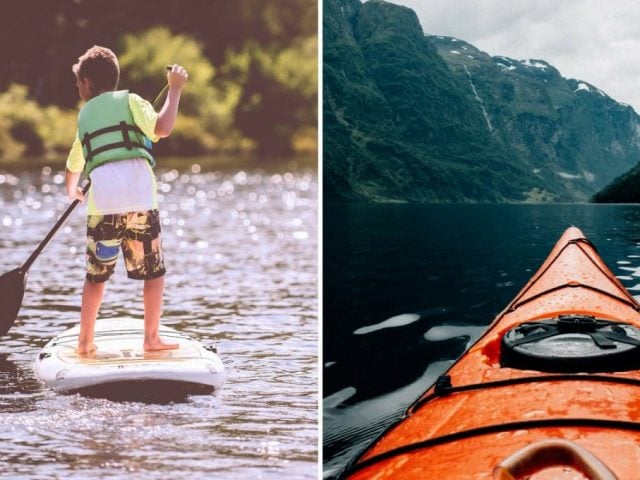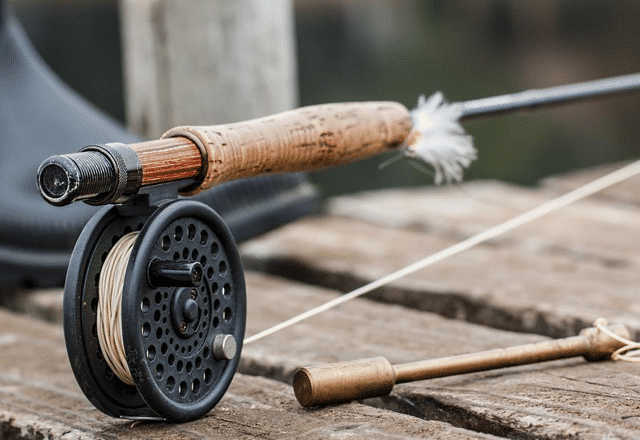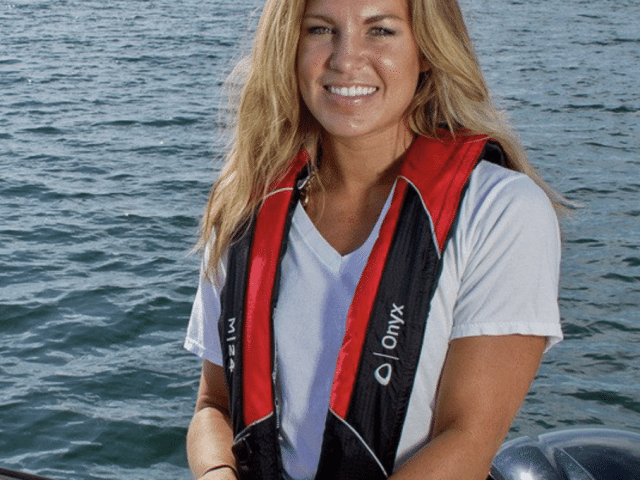Whether you need a wetsuit for spring waterskiing or fall tubing sessions, knowing how to find the right wetsuit for the whole family is essential for all boaters. Let’s be honest: nobody wants to put on a wetsuit that someone else just finished using.
Each family member should have their own fit to enjoy insulation against cooler air and water temperatures. But choosing the right wetsuit requires careful consideration. There are many kid wetsuits out there, not to mention wetsuits for men versus women that each come with their own specific fit guidelines.
So here’s your guide to selecting the right wetsuit for yourself and for your family members:
Understanding Wetsuit Thicknesses

Thickness dictates how much insulation a wetsuit offers. A thicker winter wetsuit is recommended for colder temperatures and a thinner design will be fine in milder temperatures. These thicknesses are measured in millimeters.
For example, let’s say you find a model with an advertised thickness of 4/3 millimeters. The first number represents the torso thickness. The second number signals the thickness in the arms and legs. If there is a third number–5/4/3 for example–they represent thickness in the torso, then legs, and finally arms.
Yes, that does mean that some designs are thicker in the legs than in the arms. The thickest material is used around your torso to help you maintain core body heat. Thinner material is used for the arms and legs to provide more flexibility.
Here’s a breakdown of wetsuit thicknesses and the recommended water temperatures they are made for:
| Water Temperature Range (℉) | Recommended Thickness (mm) |
| Above 75 | Not Recommended |
| 65 – 75 | 0.5 – 2/1 |
| 62 – 68 | 2 – 3/2 |
| 58 – 63 | 3/2 – 4/3 |
| 52 – 58 | 4/3 – 5/4/3 |
| 43 – 52 | 5/4 – 5/4/3 |
| Below 42 | 6/5+ |
Keep in mind that you can always go with a thicker wetsuit if you know you are always cold when being towed behind your boat. Thicker designs are also better for windy conditions, places with colder air temperatures, and activities with less physical movement.
Wetsuit Types and Lengths

In addition to varying thicknesses, wetsuits also come in different lengths and styles. Full wetsuits are the best choice for maximum insulation, but there are scenarios in which a shorty–also known as a spring suit–may be the right wetsuit for you.
Let’s start with some quick definitions of the different types and lengths of wetsuits.
- Full wetsuits cover your entire body, including your arms up to your wrists and your legs up to your ankles.
- Shortys (or spring suits) feature thinner material and short arms or legs. You’ll find styles with long sleeves, but the legs on these suits stop just before the knees.
- Long John (or Jane) wetsuits are the inverse of the shorty. They are also made with thinner material, but instead of long sleeves and shorts, they offer full legs extending to your ankles and no sleeves (yes, kind of like overalls).
- Wetsuit tops are made to be worn with boardshorts or bikini bottoms. They are usually for warmer conditions, but they can be layered under a full wetsuit for extra insulation in cold water.
- Wetsuit bottoms are the inverse of tops and can be worn in conjunction with a top or as a substitute for boardshorts or bikini bottoms in warm conditions.
- Rashguards offer very little in the way of insulation but are great for protection from sun and sand. They are sometimes worn under wetsuits to reduce irritation.
Now that you’re more familiar with the main types, let’s add to our table from above to give you an idea of how water temperature can also impact the type and length you ultimately choose:
| Water Temperature Range (℉) | Recommended Thickness (mm) | Recommended Type |
| Above 75 | Not Recommended | Rashguard |
| 65 – 75 | 0.5 – 2/1 | Top or Shorty |
| 62 – 68 | 2 – 3/2 | Spring or Full Suit |
| 58 – 63 | 3/2 – 4/3 | Full Suit + Boots |
| 52 – 58 | 4/3 – 5/4/3 | Full Suit + Boots + Gloves + Hood |
| 43 – 52 | 5/4 – 5/4/3 | Full Suit + Boots + Gloves + Hood |
| Below 42 | 6/5+ | Full Suit + Boots + Gloves + Hood |
As you can see from this table, even the thickest full wetsuit won’t be enough as water temperatures drop past 60℉. Keep weather conditions in mind when we talk more about choosing the right wetsuit accessories (i.e. boots, gloves, etc.) later on.
Wetsuit Seam Seals

Wetsuits are not made from a single, seamless piece of fabric. Instead, multiple pieces of fabric are sealed together to create the final product. As you’d imagine, these seals are typically the weakest point in a design and, as a result, the most likely location for tears or rips to occur.
There are different methods for sealing the seams and, yes, some are better than others. A wetsuit’s seal type will also dictate the kinds of conditions it is best suited for, so knowing the main types of seam seals will aid in your search.
- Flatlock stitching will lay flat against your body to minimize irritation. Water may pass through this seal and this seal type is recommended for water temperatures above 62℉.
- Sealed seams are made using stitch panels that are glued and then blindstitched. This means the stitch doesn’t go all the way through the neoprene but instead comes back out the same side it went in. This seal type allows minimal water to pass through and is recommended for water temperatures above 55℉.
- Sealed and taped seams use the same glue-and-blindstitching technique as sealed seams, but they also feature interior seam taping that adds durability by reinforcing the seam and preventing water from leaking through. Recommended for water temps below 55℉.
You may notice a theme developing here, but let’s add to our growing table now that you know more about seam seals and how they impact your search for the right wetsuit:
| Water Temperature Range (℉) | Recommended Thickness (mm) | Recommended Type | Recommended Seal Type |
| Above 75 | Not Recommended | Rashguard | N/A |
| 65 – 75 | 0.5 – 2/1 | Top or Shorty | N/A |
| 62 – 68 | 2 – 3/2 | Spring or Full Suit | Flatlock |
| 58 – 63 | 3/2 – 4/3 | Full Suit + Boots | Sealed |
| 52 – 58 | 4/3 – 5/4/3 | Full Suit + Boots + Gloves + Hood | Sealed and Taped |
| 43 – 52 | 5/4 – 5/4/3 | Full Suit + Boots + Gloves + Hood | Sealed and Taped |
| Below 42 | 6/5+ | Full Suit + Boots + Gloves + Hood | Sealed and Taped |
Wetsuit Zipper Styles

Not all wetsuits boast zippers. Rashguards and bottoms are the most obvious exceptions but, for the rest, zipper style impacts how easy it is to get in and out of the wetsuit, as well as how it feels when it’s on.
Here’s a bit more about the pros and cons of the three main zipper styles: back zips, chest zips, and zipperless wetsuits.
Back Zips
This is the most common zipper style you’ll find on a lot of wetsuits. The zipper goes down the length of the spine and is attached to a length of cord that helps you zip it up and down. While it may not sound like it, this is actually the easiest zipper style for putting on and taking off a wetsuit.
The main disadvantage of a back zip is that water can enter the zipper at the back. That means an influx of cooler water right along your spine. Some manufacturers have invented variations to reduce this uncomfortable occurrence, but it’s still something to be aware of. And finally, back zips can restrict movement when you lean forward because the zipper lacks flexibility.
Chest Zips
Chest zips eliminate that chilly ice-down-your-spine feeling that comes with back zips, but they are a bit more difficult to get into. They feature a zippered cutout around the neck that allows you to enter through the neckline before you pull that cutout up and over your head.
The last step to getting into a wetsuit with this zipper style is to zip it closed at the chest, which is considerably easier than zipping up a back zip. Chest zips also provide more comfort and flexibility than back zips–once you get them on.
Zipperless
You will typically only find zipperless designs on thinner wetsuits, as well as tops or bottoms. This style offers the most flexibility of the three and the entry point is located in the chest or neck area. Despite their name, some zipperless designs are actually secured by a small zipper at the top, but other models use elastic or Velcro to keep them secure once they’re on.
How to Find the Right Wetsuit Fit for your Family

Considering thickness, length, seal type, and zipper style will help you narrow down your options. But the best thing you can do is to actually try a few on to find the right wetsuit fit before you add them to your collection of watersports equipment.
But how should a wetsuit fit?
Wetsuits work by keeping a thin layer of water between your skin and the neoprene material. As such, you want a skin-tight fit that minimizes the amount of water between your skin and the suit. This reduces the amount of water your body needs to heat up to stay warm.
When you put the right wetsuit on, there shouldn’t be any excessive material in the arms, legs, or torso. It should also fit snugly around your neck, which can be a new sensation if you haven’t worn one before. It’s not going to inhibit your ability to breathe, but a tighter suit will keep you warm once you’re in the water.
There shouldn’t be any excess room around your shoulders, hips, or legs once you have it on and it will be slightly difficult to get into the right wetsuit–even when it’s dry. Place a plastic bag over one foot at a time or wear your socks to make it easier to slide your feet through the legs.
While they will feel slightly restrictive, there is such a thing as a wetsuit that’s too tight. If you feel pressure when trying to raise your arms over your head or squatting down, you may want to try the next size up.
Consider your preferences when trying on wetsuits. Some prefer to wear a rashguard, bikini, or boardshorts underneath for added skin protection and insulation. If this is your preference, try wetsuits on wearing these garments underneath to find the best fit possible.
If you’re unable to try on wetsuits before buying, the best thing you can do is to consult the specific fit charts produced by the wetsuit’s manufacturer. This will provide specific body measurements that will help you choose a design that’s going to be the right fit.
Consider These Wetsuit Accessories

If you intend on taking your pontoon boat out when you know the water temperature is below 60℉, you’ll need the right wetsuit accessories to stay comfortable:
Wetsuit Hoods
Some full wetsuits actually come with a built-in hood. If yours doesn’t, adding a wetsuit hood will keep your head and ears warm when recreating in colder waters. Even though recent studies contradict those old rumors that 50% of our heat escapes through our head, we can all agree that more heat will escape without a hood than with one!
Wetsuit Gloves
Neoprene gloves are a great way to keep your digits warm in cold temperatures. They are usually available in mitten styles or as fingered gloves, but the latter provides a little more dexterity when you’re handling various water ski accessories.
Wetsuit Boots
Wetsuit boots are usually made of neoprene or an insulated rubber material to provide extra warmth for your feet and toes. Styles include round toe (like a shoe) and split-toe (with the big toe separate from the rest).
There are also internal and external split-toe designs. External split-toe boots provide the most dexterity while internal designs provide a balance of solid dexterity and the extra warmth that comes with a round-toe boot. Whichever style you choose, most feature a rugged outsole on the bottom to provide grip and protection when walking on sharp rocks or reefs.
Wetsuit Socks
The main problem with wetsuit boots is that they can be bulky if you need something that will fit inside your wakeboard bindings. As an alternative, consider neoprene wetsuit socks, which are available in varying thicknesses. These socks are typically thinner but do not offer the rugged outsole you’ll find on a wetsuit boot. So they are best for using inside bindings or in conjunction with adventure sandals or water shoes.
Wetsuits Versus Drysuits

As a final note, you should know that a drysuit is also an option if you want to keep boating in cooler weather. While wetsuits intentionally let a small amount of water in and rely on your body heat to warm that water, drysuits are designed to be completely sealed from the water.
That means, with a proper-fitting drysuit, you can have sweatpants and a jacket on underneath without worrying about your clothing getting wet. Used alone, however, drysuits aren’t designed for warmth. They are simply meant to be completely waterproof.
Traditionally, wetsuits have been preferred for watersports because they are less restrictive than drysuits. However, drysuits are being increasingly used for activities that require less flexibility, such as wake surfing.
Ready to find the right wetsuit for your whole family? Shop wetsuits at Overton’s.




